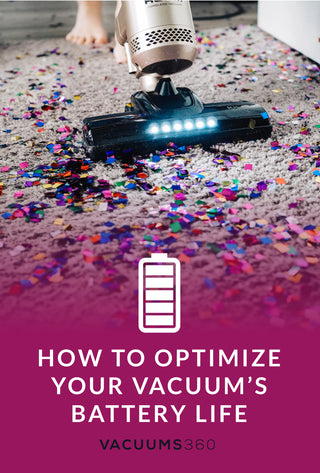Smartphones, Bluetooth headphones and speakers, wireless keyboards, computer mice, remotes and video game paddles all rely on the use of batteries, and it is no different for cordless vacuums. However, with the exception of perhaps your smartphone, a cordless vacuum’s battery life differs from these wireless devices due to the capability that you have to optimize the battery by smart usage. The advice provided below will explain how you might be able to better conserve your battery power.
Depending on the kind of cordless vacuum you purchase, the life of the battery will vary. For example, the Dyson V6 cordless may last for 40 minutes on its standard setting. Unfortunately, just like running multiple internet pages on a laptop, the more strain you put on your vacuum, the less amount of time the battery will last before dies.
Battery-powered vacuums actually share two similarities with cars. While sitting idle in a car, people often decided whether it would be better to turn the car off or not. This is because the more you turn your car off and on again, the more gasoline is used. The same principle may be applied to the battery-power on your vacuum. If you turn the vacuum on and off as you move around the house, the more the juices are used up in the battery.
Also, like blasting the max AC setting when getting in a car that’s been baking in the sun for a couple hours, it is easy to desire to turn on the maximum setting on the vacuum to get the quickest and best results. However, the battery of a vacuum like the Dyson V6 drops from 40 minutes of use to about 10 minutes. So, if you carefully take the time to work efficiently and patiently, then you will be able to preserve the battery for much longer.
When you use your vacuum but do not use up all of the battery-power, some rechargeable batteries actually do better to not charge after the vacuuming session. In fact, some higher quality batteries contain a liquid core and require the battery to be used fully before recharging or else it will not recharge as well.
Another commonly known fact about batteries is that they do not work as well if they get cold. Thus, it is wise to keep your vacuum in a closet or pantry instead of a storage area, garage or any place in your home that might be susceptible to colder temperatures. If you try charging a battery that has frozen once before, you may run the risk of causing leaks or splits in the battery case.
If you do run into a battery that has run the course of its life, it is not the end of the world. You can easily replace a battery pack by ordering the fitting pack online. Prices vary from $30-$50 and should not exceed $100. To avoid this though, use your vacuum practically and do not push the motor to its furthest limit with each use.


